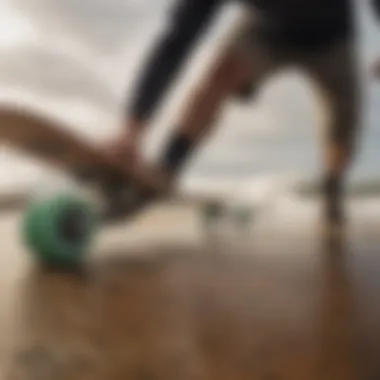Exploring Different Types of Longboards for Surfing


Intro
Longboarding has become a cherished pursuit for many, offering a unique blend of freedom and adventure. Understanding the different types of longboards isn’t just a matter of picking one from a shelf; it's about choosing a companion that matches your individual style and surfing aspirations. This guide seeks to unravel the complexities behind longboards, laying out each variant's characteristics and ideal use scenarios. Whether you are just starting your journey into the surf culture or you are a seasoned rider looking to upgrade your gear, this comprehensive exploration covers everything you need to find the perfect board to enhance your experience on the waves.
Surf Gear and Equipment
When it comes to longboarding, gear is as fundamental as the board itself. To fully enjoy surfing, one must be equipped not only with the right longboard but also with necessary accessories and technologies that elevate the ride.
Latest Surfboard Technologies
The surfboard industry has witnessed rapid advancements in technology, all aimed at improving performance and durability. Some of the latest innovations include:
- Materials: Modern longboards are often crafted with lightweight materials like fiberglass and epoxy, allowing them to glide smoothly over water while remaining resilient against wear and tear.
- Shape Variations: Custom shaping techniques enable boards to adapt to different wave conditions, enhancing maneuverability and stability.
- Fin Systems: New fin setups provide riders with options to customize their board, affecting speed and control. For instance, a thruster setup offers a balance between speed and responsiveness, while a single fin might provide more fluid movements.
These cutting-edge features can make a significant difference during a ride, allowing surfers to capture the essence and excitement of each wave.
Essential Accessories for Surfers
No surfer should venture out without at least a few key accessories. Here is a list of essentials:
- Leash: A trustworthy leash keeps the board close at hand, preventing accidents which could lead to injuries.
- Wax: Surfboard wax is crucial for maintaining grip and preventing slipping during rides.
- Protective Gear: Rash guards or wetsuits protect against the elements and may prevent irritations while riding on warm or cold water.
- Board bags: Sturdy bags shield longboards from dings and scratches when traveling or storing.
Incorporating these accessories into your routine will enhance both your performance and safety while riding.
Techniques and Skills
Keen understanding of techniques and proper skills is the backbone of becoming a proficient longboard rider. Mastery of your board can be the difference between a thrilling experience and a disappointing day at the beach.
Wave Riding Strategies
Riding waves successfully hinges on the ability to read water conditions and execute maneuvers with precision. Here are some strategies:
- Paddling: Develop efficient paddling techniques to gain speed and momentum. Utilize broad strokes to escape from breaking waves.
- Positioning: Positioning on the board is vital. Most surfers prefer hanging ten, where toes dangle over the edge, providing better control and balance.
- Turning Techniques: Learn to shift body weight adeptly; lean into turns to maintain speed and direction flow throughout the ride.
These fundamentals of wave riding can help turn an average surf session into an exhilarating ride.
Safety and Surf Etiquette
Safety is paramount in any water sport. Abiding by surf etiquette can minimize accidents:
- Respect the lineup: Wait your turn and avoid dropping in on others' waves.
- Keep a safe distance from fellow surfers to avoid collisions.
"When you respect the ocean and fellow surfers, you'll find that respect often returns to you in waves."
Proper surf conduct reflects maturity and enhances the overall experience for everyone out in the water.
As we traverse the intricate landscape of longboards, the nuances noted in this guide aim to assist surfers in making informed choices that best suit their style and proficiency. Remember, a well-chosen longboard is not just equipment; it's an invitation to experience the exhilaration of riding the waves with confidence.
Understanding Longboards
When diving into the world of longboards, it’s not just about picking a board and hitting the pavement. Understanding longboards is an essential step for anyone looking to embrace this unique mode of transportation and recreation. Longboards are more than just wider and longer versions of regular skateboards; they represent a culture, a lifestyle, and a sense of freedom on wheels. Knowing what a longboard is, its historical context, and its advantages can inform your choices and enhance your riding experience.
What is a Longboard?
A longboard is essentially a type of skateboard that is built longer and often wider for enhanced stability and control. Generally, you’ll find them measuring anywhere from 33 to over 60 inches in length. The design caters to a variety of riding styles, primarily focusing on cruising, downhill racing, and tricks. Longboards feature a variety of shapes, widths, and materials, each tailored to meet different needs and preferences of riders.
"Longboards bridge the gap between the nimbleness of a skateboard and the stability of a surfboard, offering a ride that feels like gliding on the open sea."
Diverse and versatile, longboards can be suitable for urban commuting, leisurely rides along the beach, and thrilling downhill runs. The added length gives them a distinctive feel, providing the rider with more balance, making it a favorable choice for trying your hand at various styles.
The Evolution of Longboarding
Longboarding has roots that stretch back to the 1950s and 60s when surfers, eager to maintain their skills off the water, began fashioning boards to mimic surfing on land. Initially, these boards were crude, typically made from wood or metal and looked nothing like the sleek designs we see today.
As decades passed, longboarding saw various transformations, driven by technological advances, materials changes, and shifting cultural attitudes. In the 70s, advancements in wheels, especially the introduction of urethane wheels, improved ride quality dramatically. By the 80s and 90s, longboarding gained popularity yet again, particularly within skateboarding communities. Fast forward to the early 2000s, there was a significant surge in longboard popularity spurred by a blend of urban skate culture and growing environmental consciousness. Riders began favoring longboards for commuting, enjoying a wave of alternatives to traditional fuel-based transportation.


Today, longboarding is a multifaceted sport with competitions and events held worldwide, showcasing tricks, speed, and artistry. The community surrounding it has flourished, giving rise to numerous brands focusing on diversity in design and accessibility.
Why Choose a Longboard?
Choosing a longboard over other types of skateboards can be based on several considerations that hinge on personal preference and riding style:
- Stability: The extended base allows for greater balance, making longboards suitable for beginners or those looking for a smooth ride.
- Versatility: From carving and cruising to downhill racing and even dancing, longboards can adapt to various riding styles, meeting the needs of a broad audience.
- Comfort: Longboards often allow for a more relaxed stance, reducing strain on the legs and feet during long rides.
- Environmental Impact: Many riders appreciate the eco-friendly aspects of choosing a longboard, using it as a green alternative for commuting short distances.
Longboarding offers not just a mode of transportation but an opportunity to connect with nature, engage in a community, and embrace a lifestyle. It’s not merely about getting from point A to B but relishing the journey and the ride itself.
Types of Longboards
When it comes to longboarding, understanding the types of longboards can mean the difference between a smooth, exhilarating ride or an awkward tumble. Each type is designed with specific purposes in mind, tailored to various riding styles, terrains, and user preferences. Knowing your options not only empowers surfers to pick the ideal board but also enhances the overall riding experience.
Freeride Longboards
Freeride longboards offer a unique blend of versatility and performance. They’re ideal for those who enjoy riding downhill but also want the freedom to tackle tricks and slides. The decks are usually symmetrical, accommodating switch riding. A stiff flex is common, which provides stability when cruising at speed. The wheels are often wider, helping to absorb shocks from uneven terrains.
Riders often appreciate the ability to carve tightly while initiating slides. Valeur in these boards comes from the freedom and expression they provide, turning every ride into a personal performance rather than a mere commute. They are particularly popular among those who want to practice their technique in an urban setting.
Cruiser Longboards
Cruiser longboards are perfect for casual riders who primarily use them for short commutes or leisurely rides. Their design focuses on comfort and stability, making them suitable for beginners. With a wider deck and softer wheels, cruisers smooth out bumps and cracks in the road, allowing for a relaxing ride.
Considerations for purchasing a cruiser include its ease of maneuverability and its aesthetic appeal; many come in artistic designs that can make a statement as you glide down the street. For those who enjoy a laid-back style, a cruiser longboard offers a charming way to navigate urban landscapes.
Downhill Longboards
For those who thrive on speed, downhill longboards are the answer. Built for racing down hills, these boards feature long, narrow decks for increased aerodynamics. They typically have larger, stiffer wheels designed to handle high speeds while providing maximum grip. The lower center of gravity enhances stability, which is crucial when zipping down steep slopes.
Downhill riding requires skill, as the faster you go, the more precision is needed. Riders should consider their gear carefully—helmets and protective pads are non-negotiable. Harnessing the thrill of speed can be a captivating experience; however, awareness of safety is paramount.
Carving Longboards
Carving longboards embody the essence of smooth, graceful riding. These boards are designed for making sharp turns and wide arcs, emulating the feeling of surfing on pavement. They often come with a responsive flex and are typically shorter in length. This allows skaters to easily shift their weight and make fluid movements.
A key component here is the trucks. Many carving boards are equipped with specialized trucks that allow for tighter turns, enhancing the riding experience. Ideal for those who enjoy who delight in the rhythmic flow of cruising back and forth, carving boards invite surfers to truly dance on their wheels.
Dancer Longboards
Dancing on a longboard isn't just an activity; it's a mesmerizing art form. Dancer longboards are usually longer and have a wider kicktail and nose. This allows for much freedom in movement, enabling riders to perform tricks that resemble dance moves. Followers of this style appreciate the creativity it allows; it's not just skating but expressing oneself.
When selecting a dancer longboard, the flex of the board is crucial; it affects the rider's overall ability to execute various moves. Aesthetic choices are also significant, as longboard dancing often becomes a spectacle where style and technique harmonize.
Electric Longboards
Electric longboards are like magic carpets for the modern urban rider. These boards have integrated batteries and motors, allowing the rider to reach speeds without needing to push off the ground. This makes them an excellent choice for those who want to cover longer distances with less physical effort.
Considerations here include battery life and weight. Some models are designed for high performance, while others focus on comfort. Riders will find themselves freed from the fatigue of pedaling. It's a practical solution for city dwellers looking to shorten their commute without sacrificing the fun of rolling on four wheels.
"Choosing the right longboard not only impacts your performance but also shapes the entire longboarding experience."
Finding the type of longboard that matches your style and needs can significantly enhance the pleasure you get from riding. Each type serves a different purpose in the world of longboarding. Whether you're looking for leisure, speed, or performance, there's a longboard waiting to accompany you on your journeys.
Design Characteristics
When diving into longboarding, the design characteristics of a longboard play a vital role in determining its performance, usability, and suitability for various riding styles. An understanding of these elements can greatly enhance your riding experience and ensure that you're selecting a board that fits your needs. In essence, the right design can make a world of difference between an enjoyable ride and a challenging one.
Materials Used
The materials that compose a longboard are central to its overall durability, flexibility, and riding feeling. Popular choices encompass maple, bamboo, and fiberglass. Maple is commonly chosen for its sturdy build, providing a strong, consistent ride. On the flipside, bamboo is lighter and offers improved flex, making it great for those who prefer a more agile board.
In recent years, manufacturers have also started incorporating materials like carbon fiber into the mix. While this might come at a higher price tag, it offers outstanding strength-to-weight ratios, pushing performance to the next level. It’s worth considering what materials resonate with your riding style, as some boards could crack under heavy stress while others weather the storm easily.
Deck Shapes
Deck shape is another crucial element that influences how a longboard rides. There are a plethora of shapes available, each tailored for specific riding styles. Generally, longboards might feature flat, concave, or dropped deck designs.


- Flat decks offer a stable base, generally favored in cruising situations.
- Concave decks provide better control and responsiveness, especially during turns.
- Dropped decks sit lower to the ground, which can enhance stability at high speeds and create a lower center of gravity.
When considering a deck shape, think about how and where you plan to ride. Selecting the right shape will significantly impact both comfort and control while riding.
Wheel Types
The wheels of a longboard are critical for its performance, influencing both ride quality and handling. Longboard wheels vary in size, hardness, and material.
- Size: Larger wheels glide over rough terrain more efficiently, making them ideal for downhill riding. Smaller wheels are better suited for tricks or technical riding.
- Hardness: Measured on a durometer scale, softer wheels (about 78A to 87A) provide better grip and a smoother ride on rough surfaces. Harder wheels (88A and above) usually slide better and are favored for tricks.
Choosing the right wheel type involves weighing your riding style against the terrain you'll be navigating. A well-matched wheel can enhance your ride, while the wrong choice can lead to a less than pleasurable experience.
Truck Styles
Finally, truck styles hold equal significance in determining how a longboard will maneuver. Trucks influence stability, turning radius, and how responsive your board feels. The primary truck styles include:
- Paris Trucks: Quite popular for their reliable turning capacity and stability, especially for cruising and freeride.
- Longboard Trucks: These often are wider and designed specifically for stability when going downhill.
- Riser Pads: Adding these can elevate your deck slightly for a better turning radius and reduce wheel bite.
It's important to think about the type of riding you plan to do when selecting truck styles. The right trucks can make navigating sharper turns feel smooth, giving you confidence no matter your skill level.
"Selecting the right materials, deck shape, wheel type, and truck style is like picking the ingredients for your favorite recipe. Each plays a role in ensuring the end product is just what you wanted."
In summary, the design characteristics of longboards encompass a variety of elements that directly affect performance and the overall riding experience. Understanding these components will equip you with more insight when selecting the perfect longboard for your surfing adventures.
Choosing the Right Longboard
Selecting the proper longboard can feel like hunting for a needle in a haystack, given the variety available in the market. However, making an informed choice is crucial, as it can significantly impact your riding experience. Each longboard type caters to different riding styles and skill levels, serving various purposes from cruising down the street to intense downhill racing. Understanding these differences will allow you to pick one that fits your preferences and needs, ensuring your comfort and safety on the board.
Assessing Your Skill Level
Before diving into brands or flashy designs, it's essential to assess your current skill level. Longboarding is not a one-size-fits-all activity.
- Beginner: If you’re just starting out, a wider board with a stable platform helps with balance. A cruiser longboard or a pintail may serve you well, as they offer easy maneuverability and are generally forgiving when it comes to speed.
- Intermediate: Those who've got their balance down but want to try something new might find freeride or carving boards appealing. They provide more control and are excellent for performing tricks as you hone your skills.
- Advanced: For advanced riders, downhill boards or dancers can bring added excitement and performance. They are designed for speed and precision, allowing for higher levels of control.
Whether you’re just rolling down the block or hitting steep hills, choosing the right longboard based on skill ensures a better learning experience and skidding past frustration.
Desired Riding Style
Think about where you plan to ride and what you want to achieve. Longboarding isn't just about how you look; it's deeply connected to the type of experience you're after.
- Cruising: If joyriding through the park satisfies your vibe, opt for a cruiser longboard, which is lightweight, portable, and easy to carry around.
- Freestyle and Tricks: For those hoping to perform tricks or dance moves, a board with a symmetrical design will make transitions easier.
- Downhill Racing: If speed is your game, downhill longboards have features like a lower center of gravity to help keep you anchored while you fly downhill.
- Electric Riding: Want to kick back and let technology do the work for you? Consider electric longboards that provide an extra boost, making cruising more accessible even for long distances.
The clearer you are about your riding style, the better your longboard choice will align with your ambitions, keeping your experience exciting rather than daunting.
Price Considerations
When it comes to longboarding, you often get what you pay for, so budget carefully. Prices vary widely, so knowing your financial limits is essential before making a purchasing decision. Here are some points to consider:
- Entry-Level Boards: Expect to pay around $100 to $200 for basic cruisers or beginner boards. These can serve newcomers well without draining the wallet.
- Mid-Range Boards: For $200 to $500, you’ll find higher quality construction and added features. These boards can support learning advanced techniques and provide a smoother ride.
- High-End Boards: If you want a competitive edge, be prepared for investments above $500, especially for specialized boards. They have premium materials and often come with enhanced durability and performance features.
Ultimately, consider your longboarding goals and how much you can realistically invest. Understanding your budget alongside your riding needs can prevent buyer's remorse down the line.
"Choosing the right longboard is like finding the right partner; you need to consider compatibility, purpose, and shared interests to ensure a fulfilling experience together."
In summary, taking the time to assess your skill level, define your riding style, and set a budget will steer you towards the longboard that not only meets your needs but enhances your overall journey in the world of longboarding.
Longboard Maintenance
Maintaining your longboard is not just a matter of keeping it looking sharp; it enhances performance and prolongs its lifespan. Just like any equipment you value, your longboard deserves some TLC. Regular maintenance minimizes issues like wobbling wheels, loosening trucks, or worn-out decks. Let’s dive into the essentials.
Cleaning Your Longboard
A clean longboard rides better and feels smoother. Dust, dirt, and grime can accumulate over time, affecting both aesthetics and function. It’s essential to give your board a good scrub every now and then. Here's how:
- Materials: Start with a soft cloth or sponge, and mild detergent to avoid damaging any stickers or finish. For those stubborn spots, an old toothbrush can work wonders.
- Wheels and Bearings: Check your wheels for debris, too. If you're feeling particularly industrious, take off the wheels and clean the bearings with isopropyl alcohol. A little pat on the back for not letting those creaky wheels slow you down.
- Drying: Ensure you dry off your longboard thoroughly. Leaving moisture can lead to rust or mold, especially if your board has wooden components. In short, keep it clean to keep it mean.
Replacing Components


From time to time, components may wear out, especially if you treat your longboard like a racehorse. Knowing what to replace can save you a bunch of headaches.
- Wheels: If you notice uneven wear or a flat spot, it's time to switch them out. Wheels come in various durometers and sizes. Softer wheels are best for cruising while harder ones are perfect for speed.
- Bearings: Tired bearings can lead to frustrating rides. If you find your longboard slowing down for no reason, inspect them. A quick upgrade can often restore that smooth glide, bringing your ride back to life.
- Trucks: Trucks are the unsung heroes of your board, but they can wear over time, especially if you're doing tricks. Replace them if you experience instability while riding. Opt for quality brands to ensure safety and performance.
Protective Accessories
Once you’ve invested in a solid longboard, consider protective accessories to safeguard your ride.
- Board Bags: These can prevent scratches and dents while you’re on the move. Plus, they make transporting your board much easier.
- Grip Tape: An often-overlooked component! Replace worn grip tape for enhanced control. A slippery board is a recipe for disaster—nobody wants a surprise unplanned dismount!
- Bumper Pads: They’re not just for show; they provide essential protection to the edges of your board. A few scrapes could compromise your board’s structural integrity.
"Regular maintenance can save you the cost of repairs and let you enjoy your ride, worry-free. Don't let neglect slow you down."
Longboarding Culture
Longboarding culture represents not just a sport, but a lifestyle that encompasses a passionate community of enthusiasts, activities, and a profound respect for the environment. This section delves into the various facets of longboarding culture, revealing its significance within the larger narrative of the sport. Understanding this culture is crucial for both newcomers and seasoned riders, as it shapes the way longboarders interact with each other and the world around them.
Community and Events
At the core of longboarding culture is its vibrant community. This community thrives on camaraderie and shared experiences, often found in local skate parks or specific longboarding events. Riders of all ages come together, whether for casual meet-ups or organized competitions.
These events serve multiple purposes:
- Skill Development: Participants can learn from each other,
- Networking: Riders can connect with like-minded individuals,
- Fun: The atmosphere is generally relaxed, encouraging good times and lasting friendships.
Annual gatherings, such as the unaffiliated Maryhill Festival of Speed or Slide Jam events, draw crowds from various corners of the globe. These gatherings create an invaluable platform for riders to showcase their skills, enjoy thrilling races, and even participate in workshops led by seasoned riders who share their expertise.
Such interactions foster a sense of belonging, creating bonds that extend beyond the sport. Clubs and online communities on platforms like Reddit or Facebook unite those interested, ensuring that no one feels alone in their passion for longboarding.
"In the end, it's not just about the ride; it's about the people we share it with."
Environmental Impact
As longboarding often takes place in natural surroundings, the culture heavily emphasizes environmental awareness. Riders are increasingly conscious of their impact on parks, streets, and beaches, driving home the idea that enjoyment should never come at the expense of our planet.
Here are a few key elements of this environmental focus:
- Sustainable Brands: Many longboarding companies are shifting towards sustainable materials to manufacture boards.
- Cleanup Initiatives: Many riders organize group clean-up events to preserve the spaces they love to ride in.
- Education: The community promotes environmental education, informing members about sustainability issues in their regions.
Longboarding also contributes positively by encouraging outdoor activity, which raises awareness about maintaining clean ecosystems. By nurturing a culture of respect and responsibility, longboarders can enjoy thrilling rides without leaving an adverse mark on nature.
Longboarding Influencers
Influencers play a significant role in shaping longboarding culture. These figures, from professional riders to popular vloggers, often have substantial followings on social media. They spread knowledge, inspire newcomers, and share innovative techniques, thus helping to shape community norms.
Some influential riders have gained fame through their unique styles or contributions to the sport. They are not only known for their riding skills but also for their commitment to promoting inclusivity within the longboarding community. Here’s how they contribute:
- Content Creation: Many produce engaging content that inspires others, either through tutorials or lifestyle vlogs.
- Advocacy: They often use their platforms to advocate for environmental protection or community events.
- Mentorship: Influencers frequently engage with fans, offering tips and personal experiences to help others grow in their longboarding journey.
By following these influencers, riders can access a wealth of knowledge and inspiration, further enriching their engagement with the longboarding culture
Overall, longboarding culture is a rich tapestry of community, respect for nature, and continual learning. It invites everyone into a world where rides become adventures, friendships flourish, and shared values are cherished.
Future Trends in Longboarding
As the world evolves, so too does the sport of longboarding. Understanding future trends in longboarding is vital for enthusiasts and newcomers alike. With changing technology and societal values, trends can significantly impact riding experiences, board designs, and materials used. This section delves into the advancements and eco-friendly options that surface today, which may shape the longboarding landscape of tomorrow.
Advancements in Technology
The integration of technology into longboarding has been a game changer. Riders now have access to boards equipped with smart systems, offering a range of features that enhance the experience. Consider, for instance, electric longboards—these boards use battery-powered motors to assist riders in covering longer distances without as much physical effort. Riders can now customize their riding experience, choosing settings that suit their skill level and style. Some features include:
- Regenerative braking: Harnesses energy during braking to extend battery life.
- GPS tracking: Helps riders measure distances, speeds, and location data.
- Mobile app integration: Allows for real-time adjustments and performance monitoring.
Additionally, advancements in materials have resulted in lighter and sturdier boards. Composite materials are becoming popular. They improve flex, durability, and overall performance, fitting perfectly for those looking to maximize their ride.
"The latest longboards are not just made for cruising; they integrate our tech-savvy lifestyles into just about every ride."
Sustainability and Eco-Friendly Options
As the move toward environmental awareness grows, so does the demand for sustainable and eco-friendly longboarding options. Manufacturers are recognizing their role in reducing ecological footprints. Some emerging trends in this area include:
- Bamboo and recycled plastics: Bamboo boards are prized for their strength and flexibility, while recycled plastics minimize waste.
- Eco-friendly finishes: Non-toxic paints and varnishes are increasingly used in production.
- Sustainable manufacturing processes: Companies are adopting greener practices, reducing their energy and water usage during production.
Consumers are also becoming more conscious about their purchases. Many prefer brands that reflect their values. By choosing eco-friendly longboards, riders contribute positively to the planet while enjoying their sport. The future of longboarding, therefore, lies not solely in performance but also in sustainability and environmental responsibility.















